Learn More About the Laboratory
Welcome to the kids’ page of the DuPage
County Sheriff’s Office Crime Laboratory web
site!
Here at the crime laboratory our Forensic
Scientists perform many different tests to
help the police solve crimes. One of the
basic ideas behind forensic science is that
a criminal always takes something from the
scene of a crime and always leaves something
behind. It is our job to find what the
suspect may have taken with him from the
scene or what he may have left behind.
Unlike shows you may have seen on television
our Forensic Scientists only work in the
laboratory. At the DuPage County Sheriff’s
Office we have a highly trained unit of
Police Officers who work in our Forensic
Investigations Unit. Their job is to go to
crime scenes and collect evidence which they
bring to the Crime Laboratory for testing.
The following sections talk about the
different types of evidence that is tested
at the Crime Laboratory.
Drug Chemistry
Forensic scientists in the Drug Chemistry
section are chemical detectives. They
receive unknown samples of powders, plant
material, tablets, capsules, paper and
liquids for testing. They have to determine
if these samples contain illegal drugs.
Illegal means that it’s against the law,
and a drug is anything that causes your body
to change the way it works.
First, electronic scales are used to weigh
the sample because the more illegal drug you
have, the more trouble you are in. Next,
the sample is tested. There are a variety
of tests they can use to determine if a
sample contains an illegal drug. One type
of test they perform is called a color test.
This involves taking a small amount of a
sample and adding a drop of liquid chemical.
If the sample changes color it could mean
that an illegal drug is present.
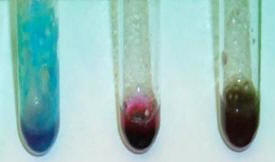 |
|
Color tests |
Another test they perform is using an
instrument, called the gas
chromatograph-mass spectrometer or the
GC/MS. A small amount of the sample is
dissolved in liquid, just like when you
dissolve Kool-Aid® in water.
Then the liquid sample is injected into the
GC/MS where it is tested. This instrument
will determine how many drugs are in a
sample and give us a chemical fingerprint
for each one. Using the chemical
fingerprints, which are unique to each
chemical, they can determine what is in a
sample.
Trace Chemistry
Some forensic scientists study tiny bits of
stuff such as hairs, fur and fibers. They
also examine splinters of glass, paint
chips, explosive residues and an almost
endless list of other small things called
‘trace evidence’. These are just a few
common examples of the tiny clues that can
be left behind at a crime scene or may get
stuck on a suspect. These different
specks of stuff transfer from the victim
onto the suspect and from the suspect onto
the victim. This transfer of clues is
called the Locard Exchange Principle.
Forensic scientists use all sorts of
different microscopes, chemical tests and
different high tech instruments to study
these tiny clues. The following sections
describe different types of trace evidence
that can be used to link a suspect to a
crime scene.
 |
|
A forensic scientist using
the comparison microscope |
Glass
When a criminal breaks into a building or a
car to steal things, they usually break a
glass window so that they can get in.
Some splinters of broken glass will fall
onto the criminal’s clothes and may get
stuck in their shoes. The police will
collect some of the broken glass from the
window. When they catch the suspect, the
police will also collect their clothes and
shoes. The forensic scientist will then
look for the glass on the suspect’s shoes
and clothes. If the glass from the crime
scene matches up with the glass on the
suspect’s clothes, this ‘glass link’ may
place the suspect at the crime scene.
Paint
In a hit-and-run car accident, a careful
search of a red car that was hit may show a
blue paint chip. The police find a car
nearby that looks like it has been in an
accident and it is blue in color. Car paint
usually contains lots of paint layers of
different colors. The forensic scientist
will study the foreign paint chip found on
the red car and compare it to the paint on
the blue car to see if all of the layers of
paint have the same color and that they are
made of the same chemicals. This helps
prove that the blue car may have been
involved in the accident.
|

|
|
A cross section of multiple
paint layers at 60x magnification
|
Hairs
Hair evidence is often found at crime scenes
and submitted to the crime laboratory.
Hairs are examined under a microscope, and
the following questions may be answered: Is
this a hair or fiber? Is the hair human or
animal? What part of the body did the hair
come from? What is the race of the hair
donor? Has the hair been exposed to
cosmetic treatment? Has the hair been
damaged in some manner?
Once these questions have been answered, the
forensic scientist can then compare
questioned hairs against known hairs using a
microscope. Sometimes animal hairs are also
of forensic value. Depending upon the
quality and quantity of an animal hair
sample, it may be possible to determine the
species of animal that a hair originated
from.
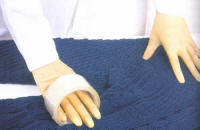 |
|
To collect hairs and fibers,
the analyst uses a piece of
clear tape, sticky side down |
Fibers
You might think if you have seen one fiber,
you’ve seen them all. But there are so many
different kinds that fiber detection can
yield a lot of clues! There are fibers of
natural materials like cotton, wool or silk.
Man-made fibers include nylon, polyester,
acetate and acrylic, and some glow under
special lights.
Some fibers, like white cotton or blue
denim, are very common. Other fibers, such
as those from certain carpets, are very
distinctive and uncommon. If unusual fibers
from a victim’s living room carpet are found
on the suspect, this is a clue that will
help prove that he may have been in the
victim’s living room.
 |
|
Cotton fibers (left) and
polyester fibers (right) at 200x
magnification |
Arson
When a suspect tries to burn down a building
he is called an arsonist. Arsonists usually
use gasoline or other flammable liquids like
kerosene or paint thinner to help start the
fire. The forensic scientist will examine
debris collected by the Fire Investigator
from the burnt building for tiny amounts of
these flammable liquid clues to help prove
that the fire was caused by arson. If the
police catch a suspect soon after the fire,
they will place the suspect’s clothes into
airtight metal cans. If the forensic
scientist finds the same kind of flammable
liquid on the suspect’s clothes and in the
fire debris, this is a clue that the suspect
may have started the fire.
Latent Prints/Other Impressions
If you look closely at your fingertips, you
can see tiny ridges covering the skin and
forming different patterns. These
patterns make up our fingerprints.
Each of us is born with these ridges already
in place and they stay there in the same
pattern for the rest of our lives.
These ridges are what help us hold on to
things, like pencils and paper. If our
fingertips were smooth, those things would
slide right out of our grip! These
ridges that make up our fingerprints are
also a good way to identify who we are,
because no two people in the world have the
same fingerprints – not even identical
twins! If you look at your
fingerprints and then look at someone
else’s, you might see some of the same basic
patterns – things that look like circles,
loops, or hills. These basic patterns
appear on a lot of people’s fingers, but the
tiny details within each pattern are
different for every single fingerprint! You
can’t see these very well unless you use a
magnifying glass, but it is these details
that allow us to say that a fingerprint
belongs to one specific person and no one
else.
|
 |
|
Typical fingerprint |
The ridges on our fingers have thousands of
sweat pores. You need a magnifying
glass to see these too. The sweat on
our fingers has some of your natural body
fluids in it and can leave an outline of
your fingerprint on an object after you
touch it. Sometimes we can see
fingerprints left behind on an object very
easily, like when your parents tell you not
to touch the walls and windows because you
are leaving behind dirty fingerprints.
Other times, these prints are difficult or
impossible to see without using special
methods to make them visible. These
types of fingerprints are called latent
prints. In the Crime Laboratory,
forensic scientists have a lot of ways to
make latent prints visible. Special
powders or chemicals are used to help find
fingerprints. Some of these turn the
fingerprints a different color so that they
can be seen, while others make the
fingerprints glow brightly when a laser
light is shined on them.
Some of you may have had ink put on your
fingers and had your fingers rolled onto a
blank card, so that your parents can have a
copy of your fingerprints. Those are
fingerprint standards or record
fingerprints. If the police have a
suspect for a crime, they can get
fingerprint standards from that person and
bring those standards to the Crime
Laboratory. Using magnifying glasses,
the standards can be compared to any latent
prints found at the crime scene to see if
they match. If they do match, then we
know that person was at the scene and
touched that object.
 |
|
Comparison of a latent print
to a fingerprint standard |
If the police don’t have any idea who might
have committed the crime, then the AFIS
computer system is used. AFIS stands
for Automated Fingerprint Identification
System. A latent print from a crime
scene is scanned into the computer.
The computer can search a database of
fingerprint standards and print out a list
of the fingerprints that look the most like
the latent print. Then the forensic
scientist uses a magnifying glass again to
see if any of the fingerprints actually
match. If they do match, then the
police have a suspect for the crime!
The computer database has fingerprint
standards from people who have been
fingerprinted before, either because they
committed a crime in the past or because
they had to be fingerprinted for their job.
The FBI database has over 250 million sets
of fingerprint standards!
Fingerprint patterns are not the only
patterns forensic scientists examine.
The palms of your hands and the bottoms of
your feet also have ridges on them with
unique patterns and footprints and palm
prints are often left at crime scenes.
Other items can leave unique prints too,
like shoes and tires. A criminal’s
shoe can be compared to a shoeprint left at
a crime scene, or a tire on a car can be
compared to a tire track from the scene.
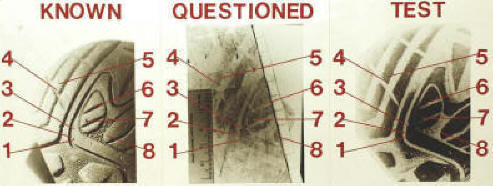 |
|
Comparison of a suspect’s
shoe (known) to the questioned
print left at the crime scene
and test print made in the
laboratory |
Firearms
Firearms examination involves the
examination of fired ammunition parts, such
as bullets and cartridge cases, to determine
if they were fired from a specific gun.
Firearms examination is actually a special
form of toolmark examination because a gun
is a tool that leaves marks on bullets and
cartridge cases when they are fired.
On the inside of a rifled gun barrel there
are lands and grooves. The lands are
raised ridges that spiral down the length of
the barrel. The lands are used to make
a bullet spin as it travels down the barrel
of the gun, because a bullet that spins will
go further and straighter than a bullet that
doesn’t spin. A bullet travels very
fast in the barrel of a gun and is
“scratched” by the spiral ridges.
Every gun leaves its own unique pattern of
scratches. Bullets have patterns of
scratches that can be matched to the guns
that fired them.
In the laboratory, shooting into a large
tank of water is a safe way to fire bullets
through the barrel of a gun so the bullets
can be collected by the scientist.
Under the comparison microscope, a firearms
examiner can examine two objects
side-by-side at the same time. The
scientist looks at the scratches on the
bullets collected in the laboratory and
compares them to the toolmarks on a bullet
found at a crime scene. If the scratches
line up in the same pattern, that’s proof to
the scientist that the police submitted the
right gun!
|
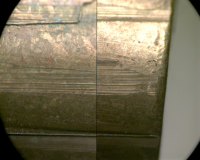 |
|
Comparison of two bullets |
|
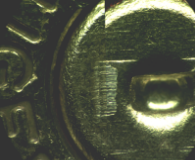 |
|
Comparison of two cartridge cases |
Toolmarks
When a hard object comes in contact with a
softer object it usually leaves a mark.
The mark left on the softer object is a
toolmark. Toolmarks can be important
clues to what may have happened at a crime
scene. Some examples of objects that
leave toolmarks are screwdrivers, hammers,
bolt cutters, guns and even teeth.
Imagine a thief used a tool to force open a
cabinet and left a scrape mark on the
cabinet. The police conduct an
investigation and find a screwdriver in a
suspect’s car. The
suspect’s screwdriver is submitted to the
crime laboratory so that test marks can be
made. A special type of microscope,
called a comparison microscope, is used to
examine marks left by tools. Using the
comparison microscope, a forensic scientist
can examine two objects side-by-side at the
same time. Under the microscope, test
marks from the screwdriver are compared to
the scrape made on the cabinet at the crime
scene. Every screwdriver makes a
different toolmark because dents and nicks
in the tool leave one-of-a-kind marks.
If the scientist matches the marks then the
police have their tool!
Forensic Biology/DNA
Body fluids like blood or spit can often be
found on items of evidence. These body
fluids contain cells and those cells contain
DNA (deoxyribonucleic acid). The DNA
is like an instruction book for our body.
Because of DNA our hearts beat, our brain
thinks, and our lungs breathe. Our DNA
tells whether we will have brown hair or
blue eyes or whether we are tall or dark
skinned. Because everyone is unique in
these characteristics, DNA must also be
unique in every individual. The only
people who have identical DNA are identical
twins. There are certain bits of the
DNA that we examine to determine a DNA
profile.
For example, imagine that someone is walking
past a jewelry store. They see some
valuable items on display in the window.
They smash the window with their fist, break
the glass and reach in to steal some of the
jewelry. While reaching in, they cut
their arm on the jagged glass and leave some
blood on the glass. Running away,
their blood drips onto the pavement along
the trail. When the police arrive on
the scene, they collect some of the blood on
the glass and some of the blood from the
trail. Maybe there is enough blood to
follow the trail all the way to a house a
few blocks away, where they find a man with
a bandage on his arm. The police can
get a sample of the man’s saliva by swabbing
the inside of his mouth with a cotton swab.
The police bring the swab of saliva from the
suspect and the swabs of the blood from the
glass and the trail to the laboratory.
The first thing the scientist would do would
be to examine the crime scene swabs and
confirm that there is blood on them.
Then the scientist would examine some of the
unique features of the DNA in the blood.
Those unique features can be compared to the
DNA of the suspect from the swab of his
spit. If both of the DNA profiles
match, we can be sure that the suspect is
the person who bled on the glass and ran
away from the store.
Now imagine if there was not a long trail of
blood, and the police were never able to
find the crook with the cut on his arm.
The biologists would still analyze the blood
and determine the DNA profile from the crime
scene. The profile would be entered
into a DNA database of people who are in
jail or who have been in jail for serious
crimes. If the crime scene profile
matches one of the bad guys in the database,
we will be able to provide his name to the
police to help solve the crime.
Some tools that forensic biologists use are
microscopes, computers and a special light
that helps us to find stains on clothing.
A bloodstain is usually visible to the eye,
but many of the other body fluids we look
for are not visible to the naked eye.
Also, once we break open the cell and take
out the DNA, DNA is not visible. We must use
chemicals and special instruments to detect
the differences in the DNA profiles.